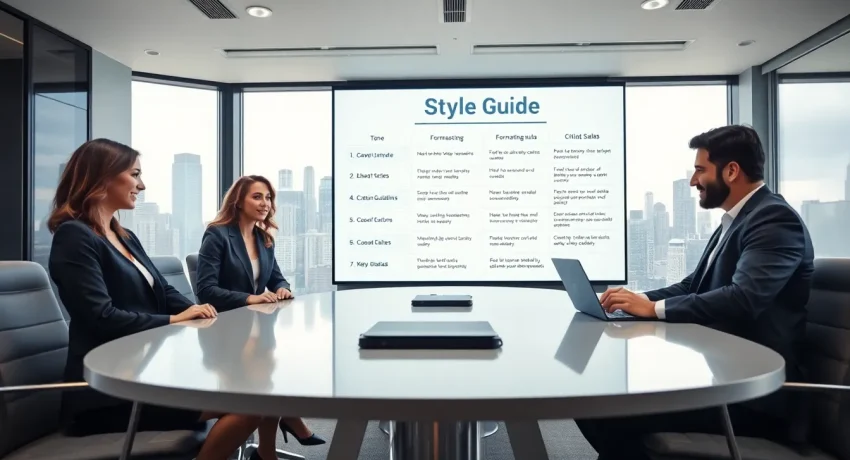Table of Contents
ToggleEver tried reading a book where the characters’ names changed halfway through? Confusing, right? A style guide prevents such chaos in writing. In essence, it’s a rulebook for clear communication, ensuring words are as polished as your favorite pair of shoes. No one wants to trip over mismatched fonts or inconsistent headings. So let’s jump into what a style guide really is and why it’s crucial for anyone looking to make their written content shine.
What Is a Style Guide?

A style guide is a comprehensive framework that dictates how written content should appear. Think of it as the GPS for communication: it guides writers, editors, and designers through the winding roads of language, tone, and format. This document helps establish consistent standards for grammar, punctuation, and citation styles while providing a cohesive look across various platforms.
Often used by corporations, educational institutions, and publishers, a style guide can be specific to an organization or aligned with established guidelines like AP or Chicago Manual of Style. Simply put, it’s the roadmap that everyone involved in content creation should follow.
Purpose and Importance of Style Guides
Style guides serve multiple important purposes, each more exciting than a coffee break on a Monday morning. First, they ensure uniformity. Whether it’s an article for a website or a report for board members, consistency in style builds trust with readers. If they see improperly formatted citations or contradictory information, they may question the credibility of the entire piece.
Also, style guides help streamline the editorial process. With all involved parties on the same page about voice and tone, less time is spent arguing over whether “color” should be spelled “colour” or if it’s acceptable to split infinitives. Instead, the focus can shift towards crafting engaging content.
Finally, they provide a foundation for brand identity. A well-defined style guide helps voice and personality shine through. It’s what sets the brand apart from competitors.
Types of Style Guides
Style guides come in various flavors to suit different needs. Here are a few common types:
- Corporate Style Guides: These are tailored for specific organizations to maintain brand voice, formatting, and language. They ensure that when someone mentions the company’s name, it comes with a consistent flair.
- Academic Style Guides: Used primarily within academic settings, these guides focus on citation and formatting standards, such as the APA or MLA style. They help students and researchers uphold the integrity of their work.
- Creative Style Guides: These provide flexibility in writing styles while maintaining a coherent voice. Often found in marketing and advertising agencies, they encourage creativity without sacrificing consistency.
- Technical Style Guides: Designed for technical writing, these guides help ensure clarity and comprehensibility in complex documents. They serve engineers, scientists, and technical writers who need to communicate intricate ideas succinctly.
Each of these guides serves a distinct function, catering to the unique requirements of their respective fields.
Key Components of a Style Guide
A well-rounded style guide typically includes:
- Tone and Voice: Guidelines on whether the tone should be formal or conversational, serious or humorous. This helps maintain a consistent narrative throughout any content created.
- Formatting Rules: Instructions on font size, spacing, headings, and overall layout so that every document looks visually appealing and maintains a professional look.
- Grammar and Punctuation: Clear reminders on common grammatical issues, punctuation use, and stylistic preferences to avoid errors that can undermine the quality of writing.
- Citation Guidelines: Whether adhering to APA, MLA, or Chicago style, citation guidelines ensure that all sources are credited correctly and consistently.
- Appendix with Examples: Real-life examples showing how to carry out the guidelines can help clarify rules and inspire writers.
Each of these components allows writers to stay focused and organized, making it easier to produce high-quality work.
How to Create an Effective Style Guide
Crafting an effective style guide isn’t rocket science, but it does require some thought. Here are some steps to get started:
- Define Your Audience: Understanding who will use the style guide can significantly influence its tone and content. Tailor it to their needs for better adoption.
- Research Existing Guides: Familiarizing yourself with established style guides can provide a framework for your own. This can save time and help align your guide with industry standards.
- Gather Input: Involve writers, editors, and designers in the development process. Their feedback ensures that the guide reflects collective preferences and practices.
- Draft the Guide: Start with a basic outline covering essential components. Don’t worry about perfection: focus on producing content that can be refined later.
- Test and Revise: Once the initial draft is complete, test it with real projects. Gather user feedback and be open to making changes for clarity and usability.
Following these steps can help streamline the creation process and result in an effective document that meets the organization’s needs.
Maintaining and Updating Your Style Guide
Creating a style guide is just the beginning. To keep it relevant, regular maintenance is crucial. Here are some strategies to ensure your guide stays fresh:
- Review Periodically: Set a schedule for reviewing the guide. Whether quarterly or annually, regular check-ups can help identify outdated information.
- Engage Users: Solicit ongoing feedback from users about how the guide is working for them. Understanding their pain points can direct necessary adjustments.
- Adapt to Changes: Language evolves, and new technologies emerge. Stay informed about trends in communication and adjust guidelines accordingly.
- Share Updates: Whenever changes are made, communicate them to all applicable personnel. Keeping everyone informed ensures that the guidelines are implemented effectively.
By actively maintaining the style guide, organizations can ensure consistency in communication while adapting to the ever-changing landscape of language.




